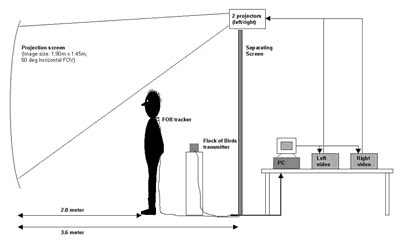
Postural responses to real-world moving video: an objective measure of presence?
W. IJsselsteijn1, H. de Ridder2 and J. Freeman3
1IPO
Center for User-System Interaction, Eindhoven University of Technology, Eindhoven,
The Netherlands
2Department of Industrial Design, Delft University of Technology,
Delft, The Netherlands
3Goldsmiths College, University of London, London, United Kingdom
Technological development in networks, computing power and displays, as well as improvements in human-system interfaces, enable the creation of services that are able to elicit a subjective sensation of 'being there' in the mediated environment. This sensation, known as presence, has been studied in relation to various media, most notably virtual environments, since the early 1990's. Two general approaches have been taken to measuring presence: subjective and objective [4]. The majority of presence studies to date have used subjective measures such as questionnaires and rating scales to assess the presence experience. These methods have the advantage that they do not disrupt the media experience, are easy to administer, and have face validity. However, subjective measures are known to be potentially unstable, with inconsistencies across different raters and rating situations [2]. In addition, subjects may be responding to the demand characteristics of the experiment, rather than reporting on their actual psychological state. An alternative approach is to measure user responses that are produced automatically and without conscious deliberation, but are still sensibly correlated with measurable properties of the medium and/or the content. Such user responses are related to presence through the premise that when observers experience a mediated environment that makes them feel present, they will respond to stimuli within the environment as they would to similar stimuli in the real world [3]. Following this principle, termed behavioural realism, we report an experiment in which we measured postural responses to real-world moving video.
Twenty-four observers (13 female, age range 18-30, all with normal vision and good stereo-acuity) were shown a video sequence shot by stereoscopic cameras positioned on the bonnet of a rally car travelling at speed around an off-road rally track, using stereoscopic and monoscopic presentation. Observers viewed the stimulus film on a large curved stereoscopic projection display with an image size of 50 degrees visual angle horizontally. A Flock of Birds“ magnetic position tracker was used to measure observers' x, y, z positions (Figure 1). Results demonstrated a significant effect of motion on the magnitude of the lateral postural movements for the stereoscopic viewing condition. A significant effect of both stereoscopic presentation and image motion on post-test subjective ratings of presence was found, consistent with results from earlier experiments [1,3]. This provides weak support for the use of postural responses as an objective corroborative measure of presence, in particular for evaluating displays intended to provide a sense of movement.

Figure 1. Schematic diagram of the laboratory set-up illustrating the observer's position in relation to the display.
Paper presented at Measuring Behavior 2000, 3rd International Conference on Methods and Techniques in Behavioral Research, 15-18 August 2000, Nijmegen, The Netherlands